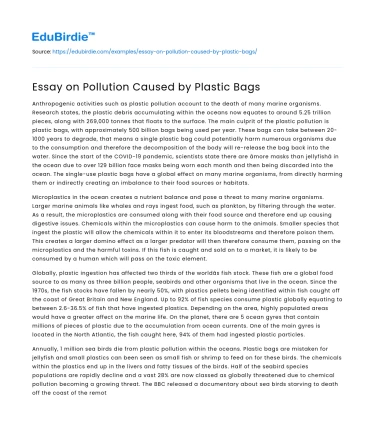Anthropogenic activities such as plastic pollution account to the death of many marine organisms. Research states, the plastic debris accumulating within the oceans now equates to around 5.25 trillion pieces, along with 269,000 tonnes that floats to the surface. The main culprit of the plastic pollution is plastic bags, with approximately 500 billion bags being used per year. These bags can take between 20-1000 years to degrade, that means a single plastic bag could potentially harm numerous organisms due to the consumption and therefore the decomposition of the body will re-release the bag back into the water. Since the start of the COVID-19 pandemic, scientists state there are âmore masks than jellyfishâ in the ocean due to over 129 billion face masks being worn each month and then being discarded into the ocean. The single-use plastic bags have a global effect on many marine organisms, from directly harming them or indirectly creating an imbalance to their food sources or habitats.
Microplastics in the ocean creates a nutrient balance and pose a threat to many marine organisms. Larger marine animals like whales and rays ingest food, such as plankton, by filtering through the water. As a result, the microplastics are consumed along with their food source and therefore end up causing digestive issues. Chemicals within the microplastics can cause harm to the animals. Smaller species that ingest the plastic will allow the chemicals within it to enter its bloodstreams and therefore poison them. This creates a larger domino effect as a larger predator will then therefore consume them, passing on the microplastics and the harmful toxins. If this fish is caught and sold on to a market, it is likely to be consumed by a human which will pass on the toxic element.
Save your time!
We can take care of your essay
- Proper editing and formatting
- Free revision, title page, and bibliography
- Flexible prices and money-back guarantee
Globally, plastic ingestion has affected two thirds of the worldâs fish stock. These fish are a global food source to as many as three billion people, seabirds and other organisms that live in the ocean. Since the 1970s, the fish stocks have fallen by nearly 50%, with plastics pellets being identified within fish caught off the coast of Great Britain and New England. Up to 92% of fish species consume plastic globally equating to between 2.6-36.5% of fish that have ingested plastics. Depending on the area, highly populated areas would have a greater affect on the marine life. On the planet, there are 5 ocean gyres that contain millions of pieces of plastic due to the accumulation from ocean currents. One of the main gyres is located in the North Atlantic, the fish caught here, 94% of them had ingested plastic particles.
Annually, 1 million sea birds die from plastic pollution within the oceans. Plastic bags are mistaken for jellyfish and small plastics can been seen as small fish or shrimp to feed on for these birds. The chemicals within the plastics end up in the livers and fatty tissues of the birds. Half of the seabird species populations are rapidly decline and a vast 28% are now classed as globally threatened due to chemical pollution becoming a growing threat. The BBC released a documentary about sea birds starving to death off the coast of the remote Lord Howe Island, in Australia. Due to the consumption of shear plastic, the birds had no room left for food. With the extreme amount of plastic in the ocean, the birds couldnât identify plastic from non-plastic and therefore ingested it.
Coral reefs are heavily populated by many juvenile fish species and used as nurseries for fish eggs due to the protection from strong ocean currents and large predatory marine species. The increasing pollution caused by plastics within the oceans has led to the rapid decline of many coral reefs globally and therefore resulting in the habitats of these juvenile fish to disappear. In Thailand, the damage caused to coral reefs has increased from 30% to 77% with the majority of the damage being caused by human destruction. Plastic pollution spreads various diseases throughout the coral reefs at alarming rates, meaning the coral has no time to recover and therefore dies. Areas situated in hot temperatures and high pollution zones, such as Thailand, are severely affected. Between 2011 and 2014, 159 locations were identified and found a strong correlation between plastic pollution and coral health. Before encountering plastics, the corals illness chances were 4%, after contact, this increases to 89%. Plastic bags may also cover the corals sunlight and their food source. Meaning, they cannot photosynthesis or eat resulting in further death caused from the plastic. As sated before the coral reefs are areas where nesting fish lay eggs and the juvenile fish grow. With coral reefs depleting this has an indirect affect on the future of these species of fish and the global fish stock.
To sum up everything stated, plastic pollution is slowly killing the oceans. Fish stocks are on the decline and many other marine organisms and both directly and indirectly being harmed by the plastic debris being neglected into the oceans. With over half the worldâs entire fish stock becoming depleted since 1970, it does not leave much time left before there are no fish left to feed on. Prevention of the plastic pollution within the oceans is needed in drastic effect to reduce the impacts. Within the United Kingdom a 20p plastic bag fee has been introduced, since then an 83% decrease of plastic bags has been sold by large retailers. Within Bangladesh, the 1988 and 1998 floods were severely increased due to plastic bags clogging drains. Therefore, the country introduced a national ban on plastic bags. Countries making national changes like these allow single-use plastics to be reduced significantly and as a result, less and less plastic ends up polluting the oceans water and harming endangered marine organisms.






 Stuck on your essay?
Stuck on your essay?

